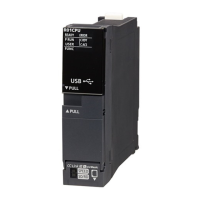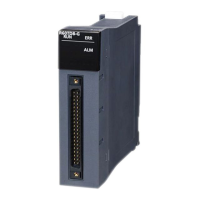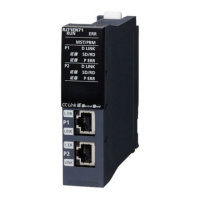214
11 DATA LOGGING FUNCTION
11.16 Precautions to Take When Using the Data Logging Function
Behavior that occurs while collected data is stored in the target memory
If one of the following operations is performed while collected data is stored in the target memory, any unsaved data is cleared
and not reflected to the results:
• Powering off and on the CPU module
• Reset
If one of the following operations is performed, unsaved data continues to be stored in the target memory:
• Changing the operating status of the CPU module from RUN to STOP
• Suspending the data logging by turning off and on of the special relay areas SM1312 to SM1321 (Data logging setting No.1
to 10 Data logging suspend/resume flag)
• Stopping/suspending data logging from within CPU Module Logging Configuration Tool
• Issuing the LOGTRGR instruction
Creating files and folders
Under the "LOGGING" folder that contains data logging setting files and data logging files, do not attempt to create files or
folders using a personal computer or other device. Doing so may result in deletion of files and folders.
When collection is performed at the specified time
When "Time specification" is selected for the data collection condition and the collection at the specified time is selected
rather than data collection during the END processing, check the collection interval by referring to the information reported in
the collection interval column. Do not rely on the information reported in the date/time column because it may be incorrect due
to clock accuracy error.
Changing the clock data
Whatever changes, such as advancing or reverting the clock, are made to the clock data of the CPU module during data
logging, the CPU module performs data collection at the specified collection interval/timing, but the date/time column in the
output file reports the changed clock data.
Events that are not recognized as a trigger condition
For trigger logging, the following events are not recognized as a trigger condition:
• A second trigger condition is met after the first trigger condition is met.
• The data condition specified as part of the trigger condition is met within the I49 interrupt program.
If a data condition is specified as part of the trigger condition, any trigger condition met during the execution of
the I49 interrupt program will not be recognized as a trigger condition. In this case, using I48 instead of I49
allows for avoiding the timing when the condition is not met.
Access to an SD memory card or the function memory
If data logging is performed with a setting that the data collection interval is short or the number of records to be collected is
large, access (read/write) to an SD memory card or the function memory occurs so frequently that a delay occurs in
completing the access. To avoid such a delay, use the following workarounds:
• Increase the data collection interval/timing.
• Reduce the number of data records to be collected.
• Lower the frequency of file switching.
Access to the CPU module during data logging
When the multiple data logging settings are started at the same time (when the multiple data logging settings are registered
again at the same time), a time-out error may occur in communications or a dedicated instruction issued from a peripheral to
the CPU module. Take measures such as increasing the time-out time period of the peripheral, reducing some data logging
settings, and stopping the other functions.

